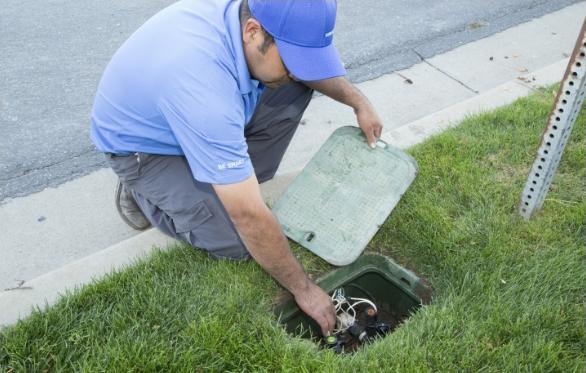It’s that time of year! The weather is cooling down and everyone is heading inside. It’s time for winterizing your irrigation system and prepping for the freezing temperatures. If you are in an area where temperatures get below freezing, it’s important for you to winterize irrigation systems in order to keep them healthy and functional.
Winterizing may not apply to everyone because not everyone lives in an area that gets cold enough for winterizing. But understanding these tips will also help you avoid costly irrigation repairs in the future. Here is Smart Rain’s tips for winterizing your irrigation system:
Winterizing Irrigation Systems: Why?
What is winterizing? How do I do it? And why do I need to do it?
Winterizing irrigation systems is a process of preparing your system for the winter months. When the freezing temperatures come, water changes states. The moisture that is left over in your irrigation system can cause serious damage if it’s not monitored and taken care of correctly. This process, known as winterizing, involves draining water from the pipes and shutting off the system to protect it from freezing temperatures.
Water expands when frozen, and this expansion can cause damage to your irrigation system's pipes, valves, and other components. This damage may result in costly repairs or replacements come springtime. By winterizing your system, you are taking proactive measures to prevent potential damage that could occur during the cold winter months.
Winterizing not only keeps your system from breaking, it also saves you money! Not winterizing your irrigation system can lead to damage that requires repair or replacement. These unexpected costs add up and can put a strain on your budget. By winterizing your system, you are investing in its longevity and avoiding unnecessary expenses.
Steps for Winterizing Irrigation Systems
1. Turn off the main water supply
The first step to winterize your irrigation system is to turn off the main water supply. It may be a little tricky to find out where the water supply is on your commercial property—as the supply/service valves for the water could be located anywhere. Some locations have several shut off valves, such as multiple tenant properties. If you don’t know where the shut-off valve may be, your next task is to find the main water shut-off valve. When you are ready to turn off the water for the end of irrigation season, be sure to account for all the valves on your property. Also, be sure that you ONLY shut off the valves that are specific to your irrigation. Properly doing is this essential for winterizing.
2. Turn off your irrigation controller or timer
Once you’ve located your main valve and shut it off, it’s time to locate your irrigation controller to set it for the winter months. Depending on what kind of controller you have, you’ll need to program it to what your system needs. Using the scheduling function, you’ll want to assess what your current scheduling is. Once you understand how you’ve been watering, set a new schedule for the system for winterizing.
Each system that you interact with will act differently according to which controller you have. So, it’s important to connect with the company that you work with in order to delay or pause watering for the season.
For Smart Rain SmartController™ users, you can pause irrigation from your controller by navigating to the homepage for your SmartController™. Once there, you’ll want to look for the “Site Status” section. There, you will see a button labeled “Suspend Irrigation.” Once this button is clicked, your irrigation will stop until you come back to turn it on. The “Interrupt” function on your controller’s homepage is not the function you’ll want to use for winterizing. That function is for temporary use.
3. Drain the remaining water from your irrigation system
This is an essential step to winterize irrigation systems. As mentioned before, when water expands, it can freeze and wreak havoc on your irrigation pipes. Once you have turned off the main water supply to your irrigation system, you need to locate and open all drain valves on your irrigation system. These can usually be found at the low points of the pipes or sprinkler heads. This will allow the water to run out of the pipes preventing frozen pipes. This is essential for winterizing
Next, you’ll want to use an air compressor, which is the most efficient way to remove any remaining water from your irrigation system. Connect the compressor to the mainline and blow out all the water through the open drain valves. It is recommended to use an air compressor with a minimum of 50 cubic feet per minute (CFM) output at 80 pounds per square inch (psi). After blowing out all visible water from your system, repeat the process at least one more time to ensure that all water has been removed. This may take a long time, but you will thank yourself after winterizing prevents leaks and gives you a healthy irrigation system.
*Additional note: If your commercial property has a backflow preventer, it is crucial to drain and blow out this component separately. This will help prevent any damage to the preventer and can be a great addition to your winterizing process.
4. Insulate the above-ground irrigation parts
Now that you have the pipes and underground irrigation covered, it’s time to focus on some of the external elements in your irrigation system. Disconnect all hoses and sprinkler heads from your system, as they can also freeze and cause damage. Store them in a dry place for the winter. Wrap your valves and backflow preventers with insulation blankets or towels to keep them from freezing. It may seem tedious, but winterizing isn't an easy process.
It may also be a good idea to install freeze sensors on your irrigation system to better utilize your system through winterizing. This may initially cost you in the short term. But the long-term benefits could save you a bunch of money if freezing damages your irrigation system.
Conclusion
Winterizing your irrigation system is crucial for protecting your landscape and preventing damage to pipes, sprinklers, and other components of the system. By thoughtfully and thoroughly winterizing your irrigation system, you can ensure a successful irrigation system startup in the spring. Some may see winterizing as a menial or tedious task, but here at Smart Rain, we believe that with patience, you’ll successfully winterize your system and also save time, water, and money! Don’t give up!



